The History Of Jaguar

Jaguar Cars Limited is a high-end car manufacturer with its headquarters in Coventry, England, now owned by Indian-based Tata Motors and operated as part of Jaguar Land Rover.
The company was founded as the Swallow Sidecar Company in Blackpool in 1922, changing to SS Cars Ltd in 1934 in Coventry, and finally becoming Jaguar Cars Ltd in 1945. Following several subsequent changes of ownership since the 1960s, the company was listed on the London Stock Exchange and became a constituent of the FTSE 100 Index, but is now owned by India's Tata Motors, and was acquired together with Land Rover from Ford on 2 June 2008.
Jaguar Cars holds Royal Warrants from HM Queen Elizabeth II and HRH Prince Charles.
Founded as the Swallow Sidecar Company in 1922, by two motorcycle enthusiasts, William Lyons and William Walmsley, the SS Jaguar name first appeared on a 2.5 litre saloon in 1935. The Jaguar name was given to the entire company in 1945 when the SS was dropped due to lack of popularity from WWII.
Jaguar made its name in the 1950s with a series of elegantly-styled sports cars and luxury saloons. The company bought the Daimler Motor Company (not to be confused with Daimler-Benz), in 1960 from Birmingham Small Arms Company (BSA). From the late 1960s, Daimler was used as a brand name for Jaguar's most luxurious saloons.
Mergers and nationalisation
Jaguar merged with the British Motor Corporation (BMC), the Austin-Morris combine, to form British Motor Holdings (BMH) in 1966. After merging with Leyland, which had already taken over Rover and Standard Triumph, the resultant company then became the British Leyland Motor Corporation (BLMC) in 1968. Financial difficulties and the publication of the Ryder Report led to effective nationalisation in 1975 and the company became British Leyland Ltd (later simply BL plc).
In the 1970s the Jaguar and Daimler marques formed part of BL's specialist car division or Jaguar Rover Triumph Ltd until a restructure in the early 1980s saw most of the BL volume car manufacturing side becoming the Austin Rover Group within which Jaguar was not included.
Privatisation
In 1984, Jaguar was floated off as a separate company on the stock market — one of the Thatcher government's many privatisations.
Purchase by Ford
The Ford Motor Company made an offer to purchase the company in September 1989 which was adapted at an Extraordinary General Meeting in January 1990 and Jaguar was removed from the London Stock Exchange listings on 28 February 1990. In 1999 it became part of Ford's new Premier Automotive Group along with Aston Martin, Volvo Cars and, from 2000, Land Rover; Aston Martin was subsequently sold off in 2007. Between Ford purchasing Jaguar in 1989 and selling it in 2008 it did not earn any profit for the Dearborn-based auto manufacturer.
Since Land Rover's 2002 purchase by Ford, it has been closely associated with Jaguar. In many countries they share a common sales and distribution network (including shared dealerships), and some models now share components, although the only shared production facility is Halewood, for the X-Type and the Freelander 2. However operationally the two companies were effectively integrated under a common management structure within Ford's PAG.
Sale by Ford
On 11 June 2007, Ford announced that it planned to sell Jaguar, along with Land Rover and retained the services of Goldman Sachs, Morgan Stanley and HSBC to advise it on the deal. The sale was initially expected to be announced by September 2007, but was delayed until March 2008. Private equity firms such as Alchemy Partners of the UK, TPG Capital, Ripplewood Holdings (which hired former Ford Europe executive Sir Nick Scheele to head its bid), Cerberus Capital Management and One Equity Partners (owned by JP Morgan Chase and managed by former Ford executive Jacques Nasser) of the US, Tata Motors of India and a consortium comprising Mahindra and Mahindra (an auto manufacturer from India) and Apollo Management all initially expressed interest in purchasing the marques from the Ford Motor Company.
Before the sale was announced, Anthony Bamford, chairman of British excavators manufacturer JCB had expressed interest in purchasing the company in August 2006, but backed out when told the sale would also involve Land Rover, which he did not wish to buy. On Christmas Eve of 2007, Mahindra and Mahindra backed out of the race for both brands, citing complexities in the deal.
On 1 January 2008, Ford made a formal announcement which declared Tata as the preferred bidder.Tata Motors also received endorsements from the Transport And General Worker's Union (TGWU)-Amicus combine as well as from Ford. According to the rules of the auction process, this announcement would not automatically disqualify any other potential suitor. However, Ford (as well as representatives of Unite) would now be able to enter into more focused and detailed discussions with Tata to iron out issues ranging from labour concerns (job security and pensions), technology (IT systems and engine production) and intellectual property, as well as the final sale price. Ford would also open its books for a more comprehensive due diligence by Tata. On 18 March 2008, Reuters reported that American bankers Citigroup and JP Morgan shall be underwriting a loan of USD 3 billion in order to finance the deal.
Purchase by Tata Motors
On 26 March 2008, Ford announced that it had agreed to sell its Jaguar and Land Rover operations to Tata Motors of India, and that the sale was expected to be completed by the end of the second quarter of 2008. Included in the deal were the rights to three other British brands, Jaguar's own Daimler, as well as two dormant brands Lanchester and Rover. On 2 June 2008 the sale to Tata was completed.
The Swallow Sidecar company was originally located in Blackpool but moved to Holbrook Lane, Coventry in 1928 when demand for the Austin Swallow became too great for the factory's capacity. In 1951, having outgrown the original Coventry site they moved again to Browns Lane which had been a wartime "shadow factory" run by the Daimler Motor Company. Today, Jaguars are assembled at Castle Bromwich in Birmingham and Halewood in Liverpool. The historic Browns Lane plant ceased trim and final operations in 2005, the x350 XJ having already moved to Castle Bromwich two years prior, leaving the XK and S-Type production to Castle Bromwich and the X-Type at Halewood, alongside the new Land Rover Freelander 2, from 2007. A reduced Browns Lane site still operates today producing veneers for Jaguar Land Rover and others, as well as some engineering facilities.
The Jaguar company started production with the pre-war 1.5, 2.5 and 3.5 litre models which used engines designed by the Standard Motor Company. The 1.5 litre four-cylinder engine was still supplied by Standard but the two larger six-cylinder ones were made in house. These cars have become known unofficially as Mark IVs.
The first post war model was the 1948 Mark V available with either 2.5 or 3.5 litre engines and had a more streamlined appearance than pre-war models, but more important was the change to independent front suspension and hydraulic brakes.
The big breakthrough was the launch in 1948 of the XK120 sports car, with the new XK twin overhead camshaft (DOHC) 3.5 litre hemi-head six-cylinder engine designed by William Heynes, Walter Hassan and Claude Baily. This engine had been designed during the long nights during the war when they would be on fire watch in the factory. After several attempts a final design was arrived at. That is until owner William Lyons said "make it quieter". The car had originally been intended as a short production model of about 200 vehicles as a test bed for the new engine until its intended home, the new Mark VII saloon, was ready. The XK120's reception was such that production continued until 1954; it was followed by the XK140, the XK150, and the E-Type, keeping Jaguar in the sports car market.
Introducing the large Mark VII saloon in 1951, a car especially conceived for the American market, Jaguar soon found itself overwhelmed with orders. The Mark VII and its successors gathered rave reviews from magazines such as Road & Track and The Motor. In 1956 a Mark VII won the prestigious Monte Carlo Rally.
The 1955 Mark 1 small saloon was the first monocoque (unibody) car from Jaguar and used a 2.4 litre short stroke version of the XK engine. In 1959, the car was improved with a larger engine and wider windows and became the Mark 2, one of the most recognizable Jaguar models ever produced. It would be popular with British police forces for its small size, light weight, and powerful engine.
The Mark VIII of 1956 and Mark IX of 1958 were essentially updates of the Mark VII but the Mark X of 1961 was a completely new design of large saloon with all round independent suspension and unibody construction.
The independent rear suspension from the Mark X was incorporated in the 1963 S-Type which closely resembled the Mark 2, and in 1967 the Mark 2 name was dropped when the small saloon became the 240/ 340 range. The 420 of 1966, also sold as the Daimler Sovereign, put a new front onto the S-type, although both cars continued in parallel until the S-Type was dropped in 1968. The Mark X became the 420G in 1966.
Of the more recent saloons, the most significant is the XJ (1968-present), still the definitive Jaguar saloon car for many. Since 1968 the Series I XJ has seen major changes in 1973 (to Series II), 1979 (Series III), 1986 Europe/ 1987 United States (XJ40), 1995 (X300), 1997 (to the V-8 powered X308), 2003 (the present model, X350). The most luxurious XJ models carry either the Vanden Plas (US) or Daimler (rest of world) nameplates.
The name is pronounced / ˈdʒægjuːɚ/ "jag-u-ar" (except in North America where it is often pronounced / ˈdʒægwɑr/ "jag-wahr") with the term "Jag" being used colloquially.
Sports:
- 1948–1954 XK120
- 1954–1957 XK140
- 1957–1961 XK150
- 1961–1974 E-Type
- 1975–1996 XJ-S
- 1992-1994 XJ220
- 1997–2005 XKR (X100)
- 2007-date XKR (X150)
Compact & Medium Executive:
- 1935–1949 1½ Litre saloon
- 1955–1959 Mark 1
- 1959–1967 Mark 2
- 1963–1968 S-type
- 1966–1968 420
- 1966–1968 240 & 340
- 1999-2008 S-type
- 2001-date X-type
- 2008-date XF
Large Executive:
- 1935–1948 2½ Litre saloon
- 1937–1948 3½ Litre saloon
- 1948–1951 Mark V
- 1951–1957 Mark VII (& VIIM)
- 1957–1959 Mark VIII
- 1959–1961 Mark IX
- 1961-1970 Mark X
- 1966-1970 420G
- 1968–1987 XJ6 Series 1, 2 & 3
- 1972–1992 XJ12
- 1986–1994 XJ6 (XJ40)
- 1993–1994 XJ12 (XJ81)
- 1995–1997 XJ6 & XJ12 (X300 & X301)
- 1998–2003 XJ8 (X308)
- 2004–date XJ (X350)
Jaguar has designed in-house four generations of engines.
- Historical engines:
- Jaguar XK6 engine – inline-6
- Jaguar V12 engine – V12
- Jaguar AJ6 engine – inline-6
- Current engines:
- Jaguar AJ-V8 engine – V8
- Jaguar AJ-V6 engine – V6
The current Jaguar line-up includes the following models:
- Pirana (1967)
- XK180 (1998)
- F-type (2000) – Roadster, similar to the XK8 but smaller
- R-Coupé (2002) – Luxury four-seater coupé, closest competitor being the Bentley Continental GT
- Fuore XF 10 (2003)
- R-D6 (2003) – Compact four-seat coupé
- XK-RR – A high-performance version of last generation XK coupé
- XK-RS – Another performance-spec version of last generation XK convertible
- Concept Eight (2004) – Super-luxury version of the long-wheelbase model of the XJ
- C-XF (2007)
- C-XE (2010)
- C-XJ (2010)
The company has had major success in sports car racing, particularly in the Le Mans 24 Hours. Victories came in 1951 and 1953 with the C-Type, then in 1955, 1956 and 1957 with the D-Type. The manager of the racing team during this period, Lofty England, later went on to become CEO of Jaguar in the early 1970s. Although the prototype XJ13 was built in the mid-1960s it was never raced, and the famous race was then left for many years, until in the mid-1980s when Tom Walkinshaw's TWR team started designing and preparing Jaguar V12-engined sports prototypes for European sports car races. The team started winning regularly from 1987, and with increased factory backing the team won Le Mans in 1988 and 1990.
In the 1999, Ford decided that Jaguar would be the corporation's Formula One entry. Ford bought out the Stewart Grand Prix team and rebranded it as Jaguar Racing for the 2000 season. The Jaguar F1 program was not a success however, achieving only two podium finishes in five seasons of competition between 2000 and 2004. At the end of 2004, with costs mounting and Ford's profits dwindling, the F1 team was seen as an unneeded expense and was sold to Red Bull energy drinks owner Dietrich Mateschitz, and it became Red Bull Racing. Since 2004 Jaguar has not had an official presence in motorsport.
Notable Jaguar sports racers:
- Jaguar C-Type (1951–53)
- Jaguar D-Type (1954–57)
- Jaguar Lightweight E-Type
- Jaguar XJR Sportscars
- Jaguar XJR-9 (1988)
- XJ220 (1988)
- XJR-15 (1990)
From Wikipedia, the free encyclopedia
More About Jaguar
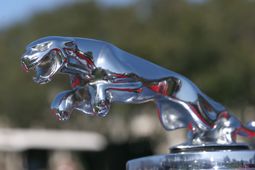
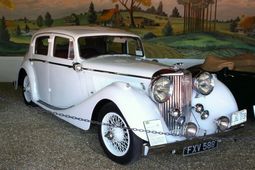
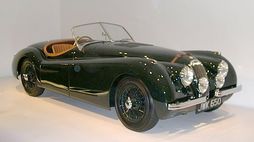
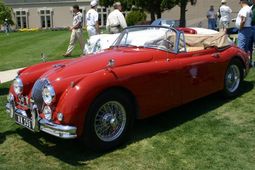
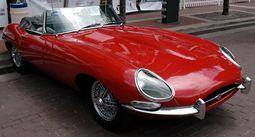

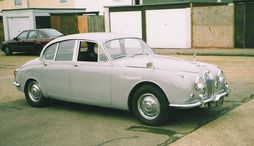


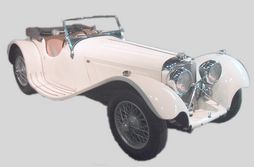
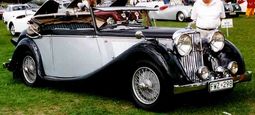
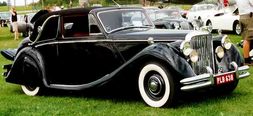

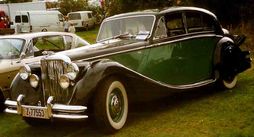



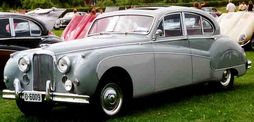

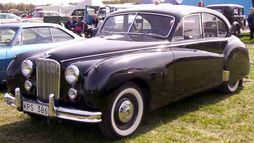


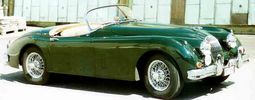


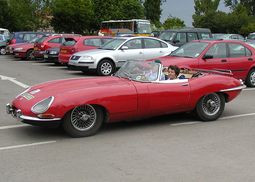
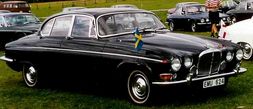
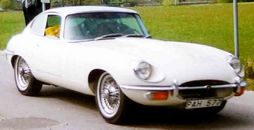
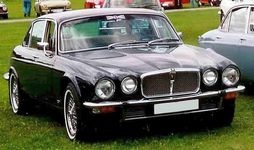
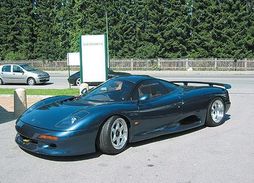
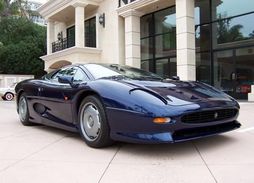
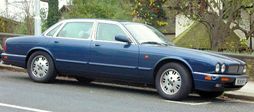
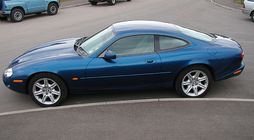
|